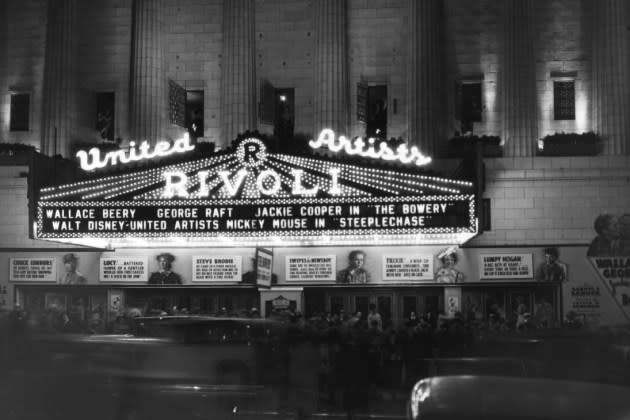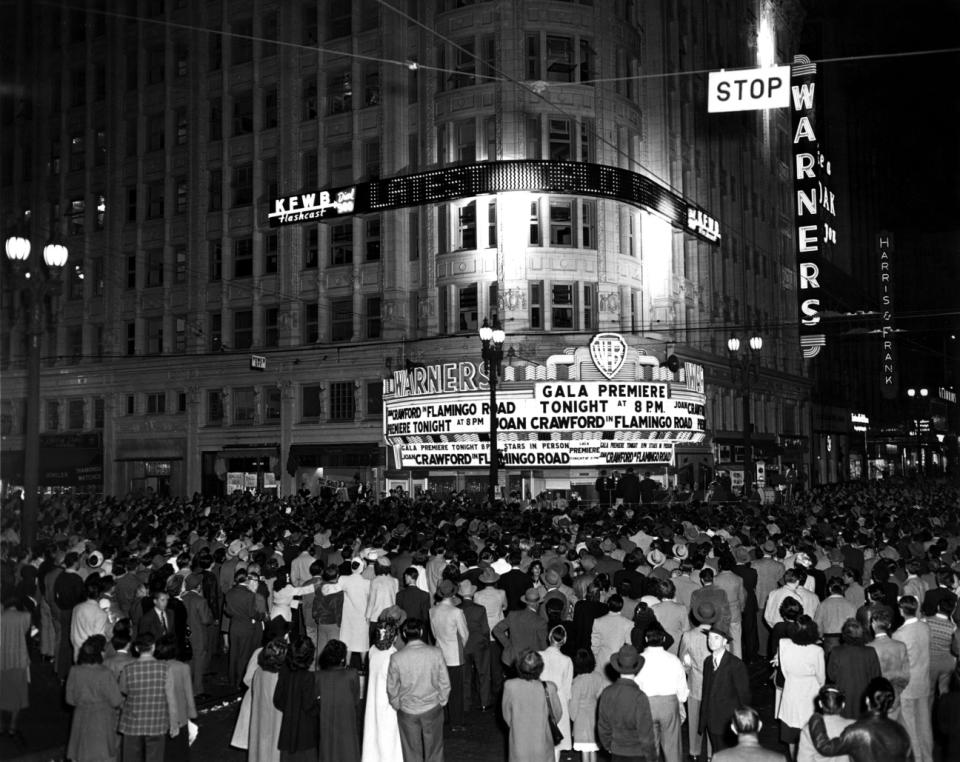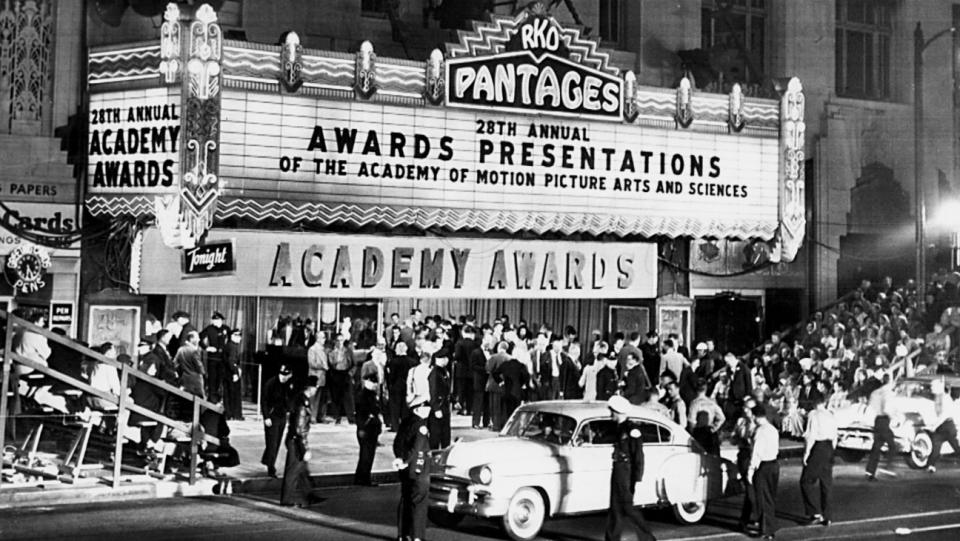The Long Shadow of Antitrust Targets From Hollywood’s Golden Age
- Oops!Something went wrong.Please try again later.
- Oops!Something went wrong.Please try again later.
- Oops!Something went wrong.Please try again later.

When the Writers Guild of America released its Aug. 17 report on “The New Gatekeepers” — naming Disney, Netflix and Amazon — it took aim at anti-competitive practices, consolidation in Hollywood and called for additional oversight for streaming platforms that are allegedly stifling creativity.
All of this has roots in the negated Paramount Decrees from 1948. As U.S. Circuit Court Judge Analisa Torres argued in ending the decrees in 2020, when the 1948 rules were put in place, there were not multiple avenues of distribution like we have today (theater, home video, internet, television). The issue of clearances, exclusivity licensing for films raised in the 1948 ruling, already occurs on streaming platforms. “There also are many other movie distribution platforms, like television, the internet and DVDs, that did not exist in the 1930s and 40s,” wrote Torres in the decision. “Given these significant changes in the market, there is less danger that a block booking licensing agreement would create a barrier to entry that would foreclose independent movie distributors from sufficient access to the market.”
More from The Hollywood Reporter
The Last Time Actors and Writers Both Went on Strike: How Hollywood Ended the 1960 Crisis
How the FBI Worked With Hollywood to Build the Crime Genre's Early Years In Film and TV
When the Paramount Decrees came down from on high in 1948, movie studios enjoyed immense control over their product and were faced with a decision of divorcement between one of the three major industry arms – production, distribution and exhibition. What came to be law in 1948 was initiated over a decade earlier in 1936, when William Benham of the Attorney General’s office began sniffing around Hollywood. Studios cooperated with the government’s research, as they had benefitted from President Roosevelt’s National Recovery Act. Finding numerous complaints from independent producers and exhibitors, the Attorney General’s office took the findings to the FBI. J. Edgar Hoover put more agents on the case, adding to the seriousness of the situation when an 89-page memo was submitted to the Justice Department. Hollywood felt no need to worry, given the industry’s pro-Roosevelt stance.
With the effects of the Great Depression still lingering in 1938, President Roosevelt leaned into an antimonopoly mindset. FDR appointed Thurmond Arnold, former mayor of Laramie, Wyoming, and professor of law at Yale, to head the Department of Justice antitrust division. After conferring with the President, the Paramount case was submitted to the Southern District Court of New York in July. The offenses were cited as follows: 1-Monopoly of exhibition in first-run metropolitan theaters; 2-Nationwide monopoly of exhibition by producer-exhibitor defendants; 3-Monopoly of production; 4-Trade practices imposed upon independent exhibitors; 5-Benefits, favors, and advantages extended by the defendants to each other.
As antitrust discussion rippled through the industry in 1938, Los Angeles Times editor Edwin Schallert noted that studio bosses were not worried because movies provided a public good. However, one major issue raised was the “exchanging of players, directors, and other talent” that was essential to major studio operations. If one studio wanted to get Katharine Hepburn for a film, they would need to loan an A-lister of their own. Such deals for top talent were mostly relegated to the top studios, something one could argue created an atmosphere that stifled competition from industry newcomers.
Harry Warner wrote to trusted FDR administrator Harry Hopkins in 1939, arguing that forcing studios to divest theater chains would hurt export trade and add risk for investing in larger budget, quality films. (By comparison, the Writers Guild West report in August argues that studio control creates an atmosphere of less quality. Recent years have found critics raising concern over the lack of originality in Hollywood.)
In 1940, The New York Times billed Hollywood as “The Unhappy Land of Make-Believe” as industry insiders noted a growing concern that the antitrust movement was gaining momentum. It didn’t help that Joseph Schenck and Joseph Moskowitz of 20th Century Fox were indicted on charges of income tax fraud, conspiracy and perjury, adding fuel to the fire for anyone looking to indict Hollywood on legal violations. Jack Warner followed up a meeting with FDR to thank the President for tasking the Department of Commerce with a structural study of Hollywood and arbitration that Warner felt would help producer-exhibitor relations in the future.

As box office attendance was nearing its peak after World War II, one of President Harry Truman’s campaign promises was to arm the Federal Trade Commission with enough ammunition to go on a trust-busting tour of the United States. It wasn’t just the film industry, everything from candy and sugar to steel and rubber was targeted. The monopoly charges facing production were dropped by 1945 but the divorcement requirement stayed, with the Justice Department suggestion divestment in exhibition. Even as late as 1946, some legal authorities such as New York Judge Augustus Hand, who was part of a New York Southern District Court hearing on the government’s antitrust case against Hollywood, thought that forcing theater divestment from studios was an “extremely drastic remedy that … this court is unlikely to grant.”
However unlikely, the studios continued to fight with countersuits. In 1947 alone, the major studios paid out $1,378,634 in legal fees to fight the antitrust cases. The carefree attitude towards the U.S. Government’s interest in Hollywood trade practices waned as other issues reared up. For example, weekly movie attendance in 1940 was 80 million, but was slipping towards 60 million in 1950.
Federal judge William Hawley Atwell spoke up on antitrust issues in a statement published in the March 11, 1948, issue of The Hollywood Reporter, contending that “the monopoly statues were originally intended for the good of the people, not the amusement of the people sitting in picture shows.” Atwell, a federal judge since 1923, also pointed to a target beyond the top producers – the stars themselves who reap “the major profits.” “When the government needs money,” mused Atwell, “we can call upon them for taxes.” The focus today, amidst a summer of labor strikes, is lofty studio CEO salaries.
Referring to postwar Hollywood’s “grim problems,” The New York Times in 1948 cited a perfect storm of issues facing the industry including “soaring costs, declining revenue (from foreign markets), the antitrust action, and the threat of television.” In addition, domestic profits declined 15-25 percent from prewar levels. Studios cut their production numbers in half. The antitrust problem raised understandable questions about competition in an industry where “major studios [are] feeding its product into its own [theater] chains.” Today, Big Streamers take advantage of a similar pipeline, controlling product from green light to living room flat screens.
The Paramount Decision that altered Hollywood business for generations was handed down from the U.S. Supreme Court on May 3, 1948, by Supreme Court Justice William O. Douglas. The statement argued that monopoly of exhibition is apparent, it isn’t necessary to prove intent of monopoly (industry has been described as a ‘mature oligopoly’). Also, Sherman Antitrust act violations were seen with the destruction and/or prevention of competition. In addition, any theater would be subject to an antitrust investigation. The primary recommendation was that studios rid themselves of their theater operations. RKO and Paramount were the first to comply, while Loew’s/MGM, Warner Bros., and Fox continued to file injunctions into February 1949. The federal court mandated the last three to divest their theater chains.
The Supreme Court was “confident that at least some of these acquisitions by the exhibitor-defendants were the products of the unlawful practices which the defendants have inflicted on the industry.” Studio ties to theater chains were a clear problem, the decree continues, “to the extent that these acquisitions were the fruits of monopolistic practices or restraints of trade, they should be divested. And no permission to buy out the other owner should be given a defendant.”
Full monopoly of exhibition was not proven, as major studios only controlled about 17 percent of the theaters around the country. When looking at larger cities (over 100,000 residents), the court found sufficient competition between independent and major studio venues. In smaller cities (50,000-100,000 residents), majors owned about 60 percent of the venues, and in small towns with less than 25,000 people, the majors controlled all theaters. What the court found was that while there wasn’t a monopoly, there was an environment with stifled competition.
It has been said that the most creative people in Hollywood are in the accounting departments. While MPAA president Eric Johnston continued to maintain that the film business was still solid, he was willfully ignoring the significant ticket sales from Hollywood’s peak in 1946 and the precipitate decline the following years, some venues saw an attendance decline as much as 25 percent. 1948 also saw a five percent drop-in box-office gross and a twenty percent drop in rentals. The numbers are from a 1949 Fortune magazine essay that could have been written today, titled “Movies: End of an Era?”

Johnston contended that we shouldn’t compare 1946, a wartime peak when people flocked to movies for escape, to 1948 when society was returning to some form of normal (with new entertainment competition). Similarly, we saw streaming boom during the pandemic and over the last year saw major box office successes reminding us not to count out theatrical exhibition. In 1949, Sam Goldwyn, “dean of the independent producers,” was quoted in Fortune as saying that “times have changed but Hollywood hasn’t,” the industry “has run dry of ideas …. a few good pictures don’t make a summer. Bust the monopoly!”
Fortune also discussed the relationship between “showman and audience” where movies where once made for the populace, to quench the thirst of the audience. After some time, “the player-audience interaction was abandoned for the recipe with ingredients.” Echoing Sam Goldwyn, the same could also be said today of the over-saturated tentpole market, where formulaic cash cows were traded for quality. “Maximizing the audience minimized invention,” stated Fortune in 1949, “People may have changed their tastes in legends since the war. An era in the [movie] world certainly ended there, and the decline in the box office may reflect it.”
Today, a new frontier of antitrust deliberation and creativity suppression is upon us. The Writers Guild raised understandable concerns about the future of what is often referred to as “content creation,” a view of art reliant only on expanding market share. The success of Barbie and Oppenheimer have shown us that non-tentpole creative can still prevail. The question remains of what type of material studios and streamers will support once the strikes are settled. The subsequent decades after the Paramount Decrees saw a rise in independent production and an increase in risk-taking that arguably culminated in the vaunted New Hollywood era. A 21st Century New Hollywood resurgence could be upon us if the right lessons are taken from the Barbenheimer summer.
Best of The Hollywood Reporter
Meet the World Builders: Hollywood's Top Physical Production Executives of 2023
Men in Blazers, Hollywood’s Favorite Soccer Podcast, Aims for a Global Empire

